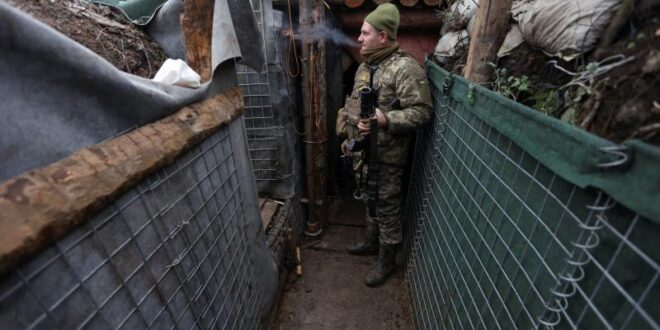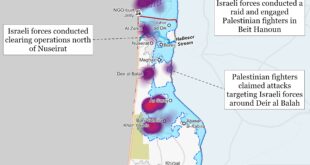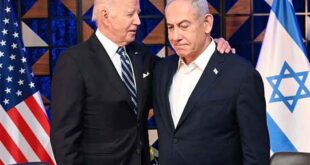Despite the Russian Buildup, the Status Quo Still Serves Both Sides
In the days leading up to and following last week’s video summit between U.S. President Joe Biden and Russian President Vladimir Putin, there has been intense speculation that Moscow is on the verge of a new military incursion into Ukraine. The United States has estimated that Russia has already deployed close to 70,000 soldiers—media reports have claimed significantly higher numbers—to several locations along Ukraine’s eastern border and in Crimea. Apparently, the Russian government is impatient with the unfinished business of the Donbas war in eastern Ukraine, which is now in its eighth year. And Putin seems to think he can prevent Ukraine’s entry into NATO by threatening a new war in the center of Europe.
Observers have been right to worry. According to The Washington Post, a U.S. intelligence report concluded that Russia may ultimately move as many as 175,000 troops to the border, forces that could be ready for a large-scale invasion as early as this winter. And as many analysts have pointed out, both countries’ armed forces are considerably stronger than they were in 2014–15, although Ukraine’s would still be thoroughly outgunned by the Russians. All this means that a new military escalation would likely be even more destructive than the last one.
Seen from the Donbas itself, however, Russia’s alarming moves take on a different cast. Given the recent turn of events in the disputed region, there are reasons to doubt Moscow’s interest in an actual invasion. This is not to say that such a dramatic step could not occur, but it would be surprising. The 250-mile frontline has hardly changed since 2015, with some 35,000 Russian-backed separatists—and likely considerably more Ukrainian troops—dug in to their positions. Having long since stopped fighting for territory, the two sides are now trading bullets and small numbers of casualties, largely to avoid the compromises that any formal peace arrangement would require. Notably, few in the breakaway areas of Luhansk and Donetsk seem to think a new invasion is likely.
In fact, over the past year and a half, Kyiv and Moscow have grown increasingly comfortable with a stalemate that brings benefits to them both. Donbas is slowly but surely separating from Ukraine and being swallowed by Russia. This trajectory is at odds with both countries’ official commitment to the region’s peaceful reintegration into the Ukrainian state. Yet the trend serves powerful interests in both Kyiv and Moscow and therefore seems likely to continue. For Kyiv, prolonging the war means that it does not have to implement a peace that would be politically and economically costly. For Moscow, the unresolved conflict means that it can continue to keep Kyiv off balance, undermining what it sees as an anti-Russian political project.
Seen from the Donbas, Russia’s alarming moves take on a different cast.
What vexes Moscow, then, is not the failure of the Minsk agreements to end the Donbas war on Russia’s terms. Rather, it fears Kyiv’s ever-closer ties to the West and NATO. In menacing an invasion, Russia is hoping to limit Ukraine’s westward slide, ensuring that its new, chilly modus vivendi with Kyiv at least remains predictable and reinforcing a situation that has given it wide control over the breakaway region.
A FAILED PEACE
The current framework for ending the war in the Donbas—the Minsk agreements of 2014 and 2015—has been ill fated from the start. When the conflict began in 2014, Ukrainian government forces appeared to be nearing victory over a chaotic assortment of Russian-armed separatists, until the Kremlin sent in thousands of regular troops to overwhelm the government forces. The resulting Minsk II protocols were effectively dictated to Kyiv, with Russia asserting broad autonomy over the areas it had helped wrest away from Ukrainian control.
For Moscow, Minsk II was a blueprint for creating Russian-backed semiautonomous states whose staunch opposition to NATO and EU expansion could be used to prevent Ukraine from joining those bodies. The agreement also had its Ukrainian defenders, including, for a time, then President Petro Poroshenko, who maintained that it gave Ukraine significant sovereignty over the region. But the Minsk approach faced strident opposition on both sides. Ukrainian nationalists saw it as a betrayal, endangering their push for a unitary and thoroughly de-Russified state; Russia’s own nationalists viewed the agreement as failing to formally unite the Donbas with Russia.
In the six years since, the anti-Minsk camps have held the upper hand. In Ukraine, nationalists pushed Poroshenko to refashion himself as an anti-Russian militarist. Then, in 2019, Poroshenko was easily unseated by Volodymyr Zelensky, who blamed him for failing to end the war. Zelensky did not promise to implement Minsk, but he did vow to wind down the military conflict. He faced vocal opposition from the Movement to Resist Capitulation, a loose coalition of hard-liners supported by Poroshenko, some of whose associates have taken credit for stopping Zelensky’s early efforts to disengage Ukrainian forces on the frontline.
Meanwhile, the Kremlin has reliably rebuffed efforts by Kyiv to find a path to peace. Since 2015, Kyiv has made numerous proposals for how an international force or a transitional administration could oversee the Donbas’s reintegration as part of Ukraine. Moscow shut down each proposal. Then, when Zelensky came to office promising to renew ties with the separatist-controlled areas, Moscow almost immediately weakened his hand by making their populations eligible for Russian citizenship. This left the new Ukrainian leader in the awkward position of trying to win back citizens who, his opponents argued, were basically already gone.
A CONVENIENT IMPASSE
Although both Kyiv and Moscow are often at odds with their own nationalist factions, both governments have in their own ways reinforced the stalemate. In Ukraine, for example, both Zelensky and the hard-line opposition that disdains him seem to believe, although for different reasons, that reintegrating the Donbas is for the moment undesirable: for the government, allowing the conflict to continue means avoiding the political minefields of reunification while benefiting from a steady supply of Western aid and sympathy. For its part, the Kremlin has backed away from its own efforts to implement Minsk, having found it more practical to pursue de facto annexation while the formal status of the of the Donetsk and Luhansk statelets remains unresolved.
Meanwhile, the two sides have not held in-person talks since April 2020, meeting instead by videoconference. Eyewitnesses to those meetings say the Russians increasingly behave as if their presence is an act of generosity, insisting that Kyiv negotiate directly with the separatists. Occasionally, there have been small breakthroughs: in July 2020, the sides managed to agree on a new cease-fire that included strict bans on return fire. But the agreement has since collapsed, in part due to Kyiv’s refusal to implement a provision calling for joint monitoring by Ukrainian and Russian-backed troops.
The ongoing fighting itself has offered perverse incentives to both sides. The steady trickle of casualties means each side can regularly provide fresh evidence of the other’s villainy. Even for the separatist leaders, whose populations have borne the brunt of civilian casualties, continued hostilities have provided a useful distraction from their own misgovernance and corruption. In Ukraine, reports of Ukrainian soldiers dying in combat provide a regular reminder of Russia’s campaign to undermine the country’s democracy. Rarely does anyone in Kyiv acknowledge that the vast majority of enemy casualties are also Ukrainians.
ANNEXATION BY OTHER MEANS
For the several million residents of the Donbas, the strategic calculations of Kyiv and Moscow mean little. In conversation, they often refer to themselves as Russian and Ukrainian interchangeably. Many are lukewarm if not hostile toward Putin, but they don’t trust Kyiv either. They are not eager for Western military assistance, because they worry that whatever the West sends could lead either side to escalate. Their dream is not to fight off the Russians or, alternately, to defeat the decadent West. What they want is for the frontline running through their home area to go away and to know what country they’re living in. Increasingly, though, the lack of resolution to the conflict has provided its own answer.
During earlier phases of the conflict, Moscow kept its financial support for the Donetsk and Luhansk statelets to a bare minimum on the grounds that they were integral parts of Ukraine. But since the spring of 2020, bilateral COVID-related restrictions have left residents of the separatist-held areas increasingly isolated from Ukraine. Before the pandemic, the five civilian checkpoints along the frontline recorded about one million crossings per month, mostly elderly people traveling to government-controlled Ukraine to collect their state pensions. In the time since, however, separatist leaders have never fully reopened the checkpoints, despite what appear to be serious efforts by Ukrainian negotiators. Crossings have shrunk to a trickle, amounting to just five percent of their previous levels. Residents who still wish to travel to Ukraine now have to undertake expensive, days-long trips through Russian territory.
With this hardening border, Russia has quickly moved to strengthen ties with the civilian populations of Donetsk and Luhansk. Russian officials say they have given Russian passports to more than 650,000 residents under the new expedited procedure introduced after Zelensky’s victory. As one resident of a separatist-held city put it, neighbors were taking advantage of the offer since “the gates are only open for us in one direction.”
Donbas residents want to know what country they’re living in.
Meanwhile, Moscow is for the first time beginning to pour substantial investments into the region. In October, Ukrainian journalists obtained a copy of a Russian government document outlining plans for “the expedited economic development” of “territory 1” and “territory 2”—code for the two statelets. The plan called for spending $12 billion on the region over the next three years, including raising the salaries of public-sector workers to match those in Russia’s neighboring Rostov Oblast. This would amount to a doubling of Moscow’s current annual spending on the breakaways and would exceed its monetary transfers to almost every region of the Russian Federation.
The Kremlin has also moved to facilitate Russian commerce in the statelets. Previously, Russian businesses had been unable to conduct legal trade there, because of the statelets’ unrecognized status. But in mid-November, Putin ordered his government to start recognizing origin certificates for goods produced in Luhansk and Donetsk, allowing them to be traded in Russia. Moreover, these goods are to enjoy priority status when it comes to state and municipal purchases. Although the long-term effects of these measures are unclear, they suggest an evolving Russian approach that is untethered to any formal status negotiations.
Until now, Kyiv has shown little interest in trying to stop Moscow’s growing hold over the Donbas. This is not necessarily because the Ukrainian government supports these efforts but because it has very limited capacity to stop them. The slide toward full separation, however, may also be a perverse win for Ukraine’s nationalists. For some years now, the hard-liners have been concerned by the continued prevalence of Russian and Russian-language media in parts of Ukraine and by the fact that many Ukrainians themselves still feel a strong cultural unity with Russia. For those seeking to cleanse the country of Russian influences—and for a handful of Western officials who support them—getting rid of the heavily Russian-speaking separatist regions that Kyiv’s own minister for reintegration has described as “mentally ill” would make life easier. Without them, they suggest, it would be possible to draw a clear, bright line between a free and democratic Ukraine, which is oriented toward the West, and an authoritarian Russia, which is not. This stance, of course, fits neatly into one of the Kremlin’s agendas: it suggests to Russians that although their government may habitually lie to them and arbitrarily imprison them, there will never be a place for people like them in a Western-style democracy.
NO WAR, NO PEACE
Russia’s latest military buildup seems to have been aimed, at least in part, at perceived Western slights and provocations, such as the presence of U.S. ships in the Black Sea and various delays to the Nord Stream 2 pipeline that is supposed to supply Russian gas to Europe without crossing Ukraine. By showing Russia’s readiness for an invasion, Putin’s primary goal may have been to force Biden into a dialogue and deter a NATO expansion. This does not mean one should ignore the risk of an accidental escalation or an impulsive move by Putin to force all of Ukraine back into Russia’s orbit. It does mean, however, that the greater worry may be that the current low-level conflict could grind on indefinitely, with occasional scares like the present one simply becoming part of the pattern of the stalemate.
For now, many residents in the region think that the current situation is unlikely to change: more than seven years of grim uncertainty have robbed them of any hope that things might get better and any interest in contemplating the possibility of things getting worse. “They say this every year,” one resident of Donetsk city remarked the other day, when asked about talk of a new escalation. “Everyone thinks this will just drag on,” said another.
One cold gray morning in November, I encountered a man smoking at the foot of a barbed-wire fence dividing Ukraine from Russia. In the past, he said, “this wasn’t even here,” gesturing to the fence. The Russians had put it up in 2018, dividing the village in half down the center of the main street. “Nobody asked us,” he said. He lived across the frontlines in separatist-held territory, earning a tenth of what he did before the war. He saw no end to the conflict as long as Putin was in power, but he was also worried about Ukraine reasserting control. “I think this is forever,” he said.
 Eurasia Press & News
Eurasia Press & News




